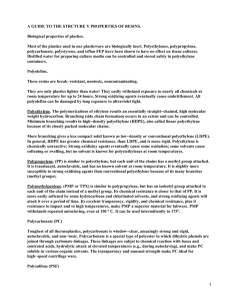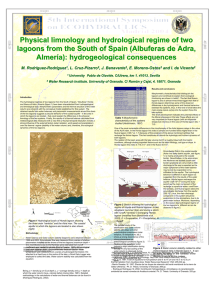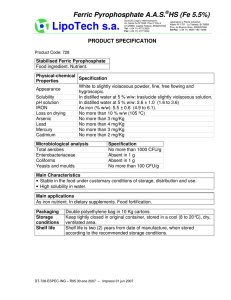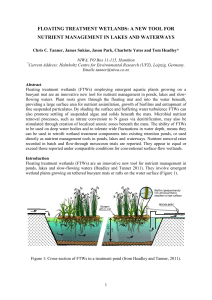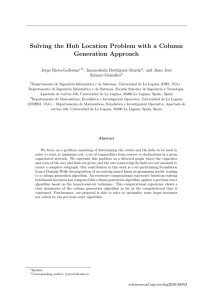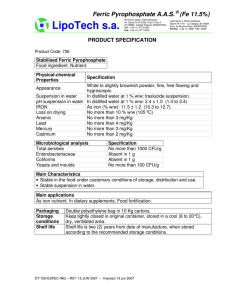Design and evaluation of benthic mesocosms for coastal
Anuncio
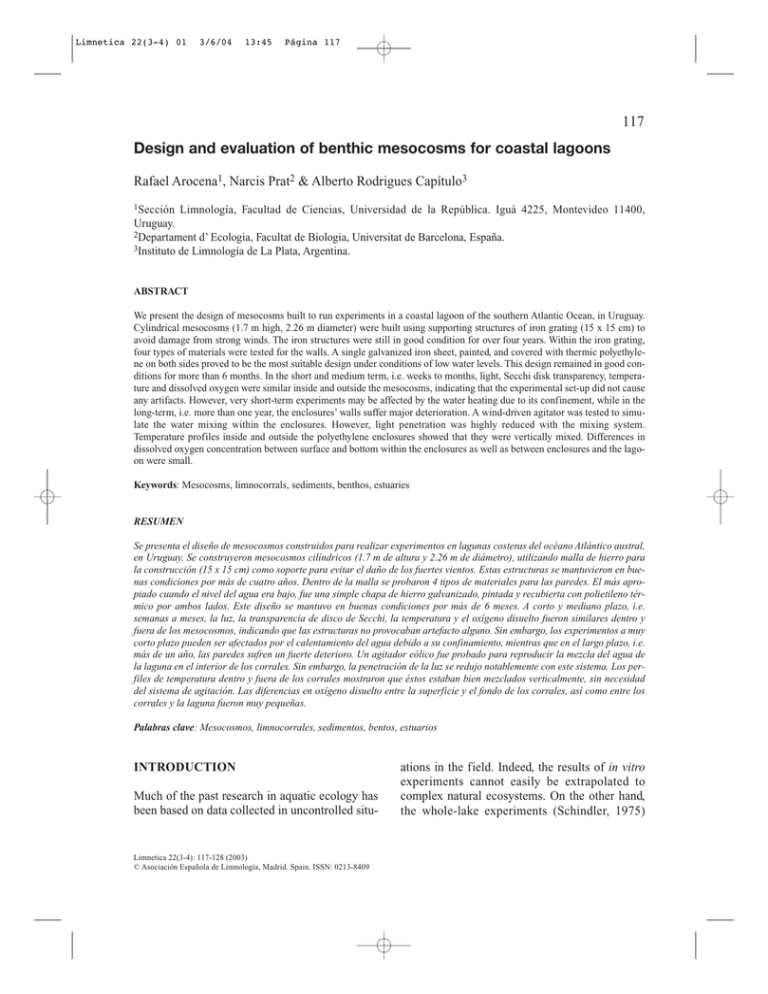
Limnetica 22(3-4) 01 3/6/04 13:45 Página 117 117 Design and evaluation of benthic mesocosms for coastal lagoons Rafael Arocena1, Narcis Prat2 & Alberto Rodrigues Capítulo3 1Sección Limnología, Facultad de Ciencias, Universidad de la República. Iguá 4225, Montevideo 11400, Uruguay. 2Departament d’ Ecologia, Facultat de Biologia, Universitat de Barcelona, España. 3Instituto de Limnología de La Plata, Argentina. ABSTRACT We present the design of mesocosms built to run experiments in a coastal lagoon of the southern Atlantic Ocean, in Uruguay. Cylindrical mesocosms (1.7 m high, 2.26 m diameter) were built using supporting structures of iron grating (15 x 15 cm) to avoid damage from strong winds. The iron structures were still in good condition for over four years. Within the iron grating, four types of materials were tested for the walls. A single galvanized iron sheet, painted, and covered with thermic polyethylene on both sides proved to be the most suitable design under conditions of low water levels. This design remained in good conditions for more than 6 months. In the short and medium term, i.e. weeks to months, light, Secchi disk transparency, temperature and dissolved oxygen were similar inside and outside the mesocosms, indicating that the experimental set-up did not cause any artifacts. However, very short-term experiments may be affected by the water heating due to its confinement, while in the long-term, i.e. more than one year, the enclosures’ walls suffer major deterioration. A wind-driven agitator was tested to simulate the water mixing within the enclosures. However, light penetration was highly reduced with the mixing system. Temperature profiles inside and outside the polyethylene enclosures showed that they were vertically mixed. Differences in dissolved oxygen concentration between surface and bottom within the enclosures as well as between enclosures and the lagoon were small. Keywords: Mesocosms, limnocorrals, sediments, benthos, estuaries RESUMEN Se presenta el diseño de mesocosmos construidos para realizar experimentos en lagunas costeras del océano Atlántico austral, en Uruguay. Se construyeron mesocosmos cilíndricos (1.7 m de altura y 2.26 m de diámetro), utilizando malla de hierro para la construcción (15 x 15 cm) como soporte para evitar el daño de los fuertes vientos. Estas estructuras se mantuvieron en buenas condiciones por más de cuatro años. Dentro de la malla se probaron 4 tipos de materiales para las paredes. El más apropiado cuando el nivel del agua era bajo, fue una simple chapa de hierro galvanizado, pintada y recubierta con polietileno térmico por ambos lados. Este diseño se mantuvo en buenas condiciones por más de 6 meses. A corto y mediano plazo, i.e. semanas a meses, la luz, la transparencia de disco de Secchi, la temperatura y el oxígeno disuelto fueron similares dentro y fuera de los mesocosmos, indicando que las estructuras no provocaban artefacto alguno. Sin embargo, los experimentos a muy corto plazo pueden ser afectados por el calentamiento del agua debido a su confinamiento, mientras que en el largo plazo, i.e. más de un año, las paredes sufren un fuerte deterioro. Un agitador eólico fue probado para reproducir la mezcla del agua de la laguna en el interior de los corrales. Sin embargo, la penetración de la luz se redujo notablemente con este sistema. Los perfiles de temperatura dentro y fuera de los corrales mostraron que éstos estaban bien mezclados verticalmente, sin necesidad del sistema de agitación. Las diferencias en oxígeno disuelto entre la superficie y el fondo de los corrales, así como entre los corrales y la laguna fueron muy pequeñas. Palabras clave: Mesocosmos, limnocorrales, sedimentos, bentos, estuarios INTRODUCTION Much of the past research in aquatic ecology has been based on data collected in uncontrolled situ- Limnetica 22(3-4): 117-128 (2003) © Asociación Española de Limnología, Madrid. Spain. ISSN: 0213-8409 ations in the field. Indeed, the results of in vitro experiments cannot easily be extrapolated to complex natural ecosystems. On the other hand, the whole-lake experiments (Schindler, 1975) Limnetica 22(3-4) 01 118 3/6/04 13:45 Página 118 Arocena et al. include the risk of causing environmental damage (Berge et al., 1986), and a large number of small samples is required to account for variability in natural systems. To overcome this problem, researchers have used either artificial land-based models (Notini et al., 1977) or enclosures that isolate a part of the aquatic ecosystem. Both systems are simplified models of the natural environment, expected to reasonably reproduce their main characteristics. Different kinds of enclosures are defined according to their size. Mesocosms are 1 to 1000 m3 if they are pelagic or closed, or 0.1 to 100 m2 if they are opened to the sediment. Microcosms and macrocosms are respectively smaller or bigger than those limits (UNESCO, 1991). Mesocosms are physically conf ined, self-suff icient systems including several trophic levels. Their volume must be large enough to avoid the wall effect (e.g., undesired growth of periphyton), and to allow frequent and relevant sampling. Enclosed populations maintain their natural proportions (Davies & Gamble, 1979), and when the mesocosms are installed, their ecological characteristics are identical to those of the natural system (Ravera, 1992). Although some alteration cannot be avoided, it can be minimized and checked by using a control (Lacaze, 1971). Furthermore, mesocosms allow running experiments with many replicates. Although replicability is as important as the maintenance of natural conditions (“realism”), these properties seem to be inversely correlated (Kuiper et al., 1983). According to Landner et al. (1989) realism must be favored against replication when the objective is to predict effects in natural systems, particularly secondary effects at the community or ecosystem level. Mesocosms opened to the sediment play an important role in the study of pollution effects on pelagic-benthic interactions (Davies & Gamble, 1979; Ravera, 1992). This is particularly important concerning the effects of sewage on coastal areas where nutrients and pollutants rapidly reach the sediments. Many different mesocosms have been developed, according to their objectives and type of water system (Davies & Gamble, 1979; Grice & Reeve, 1982; Ravera, 1989 and UNESCO, 1991). The first large mesocosm was the bag designed by Strickland & Terhune (1961) to measure primary production in the sea. Tubes smaller than those proposed in 1956 by Margalef (McAllister et al., 1961) did not maintain the natural populations due to the wall effect, which increases as the volume/surface ratio decreases (Lund, 1972). The use of mesocosms increased in the 1970’s. With the open tubes of Lund (1972) mesocosms were also used for freshwater environments, where they adopted the name of limnocorrals. Bodungen et al. (1976) included coastal sediments in the Plankton Tower of Kiel, whose exposure to the wind and marine surf required complex and heavy structures. The use of mesocosms is more recent in coastal lagoons, where land-based tanks are generally used (Taylor et al., 1995). In these tanks, water flows and mixing devices are needed. Furthermore, when sediment is introduced in the tank, the disturbance is generally high, unless extremely complicated systems are employed for their extraction and transport (Berge et al., 1986). Problems in the design of open mesocosms appear in areas affected by tides (Davies and Gamble, 1979) or by other important changes of water level. Coastal lagoons, like inter-tidal zones, are shallow, exposed to strong winds and currents, and experience continuously changing water levels. Although this variation does not exhibit the same frequency of tides, it is usually present in mid- and long-term experiments. Accordingly, mesocosms in both environments should allow a wide vertical displacement of water and resist adverse physical conditions. To overcome this problem, Schiewer (1997) designed mesocosms of polyethylene with a floating upper edge. The presence of walls reduces the penetration of light, which in the confined environment of the mesocosm could result in an alteration of Limnetica 22(3-4) 01 3/6/04 13:45 Página 119 Benthic mesocosms for coastal lagoons the temperature regime. To prevent this, mesocosm walls consist of transparent plastic, except for mesocosms whit a very large surface area. However, in shallow and usually turbid waters like those of coastal lagoons, confinement may actually lead to greater penetration of light resulting from reduced turbulence and sediment resuspension (Istvánovics et al., 1986). This problem has been overcome in some cases with mixing devices. Our purpose was to design a mesocosm to be used in experiments run in a coastal lagoon of the southern Atlantic Ocean. The main objective of this paper is to study the performance of the mesocosms developed as ecosystems and to 119 explore differences between the conditions inside and outside the mesocosm. STUDY SITE Laguna de Rocha (34° 37’ S, 54° 12’ W) has a surface area of 72 km2 and a mean water depth of 0.6 m. It is located in Southeastern Uruguay (Fig. 1). Depth changes are frequent, due to the variation of flow in the main tributaries, which reach the lagoon from the north, and also to the periodic opening of the sandy bar that separates the lagoon from the southwest Atlantic Ocean. More details about this ecosystem can be found m Figure 1. Location of Laguna de Rocha and the study area showing the location and numbering of the mesocosms. Ubicación de la Laguna de Rocha y el área de estudio con la ubicación y numeración de los mesocosmos. Limnetica 22(3-4) 01 3/6/04 13:45 Página 120 120 Arocena et al. in Sommaruga & Conde (1990), Pintos et al. (1991) and Conde et al. (1999). MATERIAL AND METHODS The area of the mesocosms was determined to be ten times larger than the area needed to collect monthly sediment samples of 10 replicates during one year with a corer of 6.0 cm in diameter (4 m2). The resulting diameter was 2.26 m and six mesocosms were installed in the lagoon on 16 and 17 September 1993. The mesocosms had a rigid structure to avoid bending of the walls. Considering a mean depth of 0.6 m and foreseeing water level rises of up to 1 m, a height of 1.6 m was considered enough for water level fluctuations during the experiment. This supporting structure consisted in a grating (15 cm x 15 cm mesh), made 4.2 mm thick iron rods (Fig. 2). As the grating used was 2.5 m wide, it was cut and a third cylinder was made by welding the remaining thirds of every two gratings. Six mesocosms were installed in a shallow site (35 cm) at the northern part of the lagoon (Fig. 1). The mesocosms were arranged in two groups of three units each like cloverleaves, and tied with wire. The gratings were buried between 20 cm and 32 cm in the sediment, thus the final height was between 135 and 147 cm. Furthermore, they were secured with four long rods completely buried in the sediment. Four kinds of walls were successively tested within the gratings (Table 1): 1) common polyethylene (N), 2) thermic polyethylene (T), 3) two superimposed galvanized iron sheets (C), and 4) one single iron sheet (c). Figure 2. Supporting structure of iron grating. Estructura de soporte de malla de hierro. Walls of common polyethylene In a first design, rigid structures 1 and 2 were covered on both sides with a sheet of transparent polyethylene (N1, N2) 200 µm thick. The inner sheet was buried in the sediment by a galvanized iron cylinder 0.5 mm thick and 30 cm high. The polyethylene covered the inner side of the foil to prevent the pollution of the system with iron, and it was clinched to the sheet’s lower edge folded outside (Fig. 3). The folding avoided the thin edge of the sheet cutting the polyethylene. The polyethylene sheet covered the upper edge and the external side of the grating. Hence, this external sheet protected the internal one that constituted the true wall of the mesocosm. Table 1. Summary of the tested designs for mesocosms walls. Resumen de los diseños utilizados para pared de los mesocosmos. WALLS MATERIAL Common Polyethylene 200 µ m Thermic Polyethylene 80-120 µ m 2 overlapped foils 0.8 mm 1 foil 1m x 0.8 mm VARIABLES ENCLOSURES PERIOD Light, Secchi disk Secchi disk Temperature Dissolved Oxygen Conductivity N1, N2 + mixer T5, T6 C3 c1, c2 17/Set/93 - 28/Set/93 15/Dec/93 - 28/Jul/94 11/Jul/94 - 19/Jan/95 2/Dec/94 - 13/Jun/95 Limnetica 22(3-4) 01 3/6/04 13:45 Página 121 Benthic mesocosms for coastal lagoons 121 Walls of thermic polyethylene In a variation of the first design, on December 15 1993, a low-density thermic polyethylene (80 - 120 µ m thick) was installed in mesocosms 5 and 6 (T5, T6). This material is used for greenhouses, and it is less likely to suffer from damage than common polyethylene due to its higher elasticity. Walls of two iron sheets In July 1994, due to problems with polyethylene bags, an enclosure made of galvanized iron sheets 0.8 mm thick was tested in mesocosm 3 (C3). As this material is 1 m wide, two rings were clinched one above the other so as to reach enough height. Rings were painted with antioxidant and white enamel for marine use to increase its lifetime. Walls of one iron sheet Last, and because the water depth in December 1994 was only 60 cm, two enclosures made of only one 1 m high iron sheet were installed in gratings 1 and 2 (c1, c2). These were also painted and then covered with thermic polyethylene on both sides. Device for water mixing A wind-driven mixing system was incorporated into the mesocosm N2 to simulate the action of the wind in the lagoon. A very simple vertical axis whirl of Savonius type (Fig. 4) was made from a common metallic bucket. The 33 cm high rotor consisted of two semi-cylinders (29 cm diameter) with their concavities confronted but laterally displaced, and sustained between two disks (56 cm diameter). The whirl stood on an iron tripod attached to the upper edge of the grating. Its rotation was driven by the wind and transmitted by a 1.5 m long axis to a plastic helix from a domestic fan located 20 cm above the bottom. Friction pieces were made of hard polyethylene. Figure 3. Detail of the joint between the lower edge of the polyethylene sheet and the metallic foil. Detalle de la unión entre el borde inferior de la hoja de polietileno y la hoja metálica. Just after installation, the whirl speed was measured by direct counting its revolutions per minute (RPM). Simultaneously, the wind speed was measured with a mechanic anemometer to establish the relationship between both. This relationship allowed estimating the rotor speed from data on wind speed obtained from a meteorological station located 10 km from the experimental site. Effects of the walls on environmental variables To evaluate the change in the light conditions within the enclosures, Secchi disk (20 cm diameter) transparency was measured on 17 occasions from 17 September 1993, to 13 June 1995, inside and outside the mesocosms. The penetration of photosynthetically active radiation (PAR: 400-700 nm) was measured inside and outside with a radiometer (Li-Cor, LI-188B) connected to a 4π sensor. These measurements were carried out immediately after the enclosures were installed and 12 days after this. Temperature and dissolved oxygen were measured several times with an YSI M57 oxymeter to evaluate the presence of vertical discontinuities in the polyethylene enclosures from September 1993 to February 1994, and those of galvanized iron from January to June 1995. The effect of the enclosure alone (N1) and that of the mixer (N2) on the temperature stratification were evaluated through four successive temperature profiles measured with an electronic thermocouple every 20 minutes on September 17, 1993 and every hour on September 28, 1993. Percentages of light penetration were compared by a 3-way ANOVA without repetitions considering the interaction of site, date, and Limnetica 22(3-4) 01 3/6/04 13:45 Página 122 122 Arocena et al. Figure 4. Wind driven Savonius rotor in frontal (left) and horizontal (right) view. Rotor eólico tipo Savonius en vistas frontal (izquierda) y horizontal (derecha) depth as a measure of the error under the hypothesis that there was no effect added by such interaction (Sokal & Rohlf, 1979). Temperature and dissolved oxygen concentration data were analyzed in the same way. These analyses were carried out with the PC program STATISTICA (StatSoft, Inc.). were finally discarded. Those walls made of thermic polyethylene stayed in acceptable condition during more than 7 months, with minimal maintenance. However, strong winds in the lagoon finally destroyed them too. The two sheets of the enclosure made of galvanized iron partially separated after 50 days. This was not a problem because the water depth never exceeded 70 cm during the whole period it was installed. Therefore, we opted to install two enclosures made of only one sheet. These enclosures lasted for more than 6 months, although the water covered them during the flood on April 7, 1995. The mixer was removed on September 28, 1993 because it reached too high velocities (up to 74 RPM) and caused an excessive sediment resuspension. The speed of the rotor (R in RPM) was exponentially correlated to that of the wind (v in km h-1) according to: R = -4.518 + 4.498 e(0.099 v) (r = 0.999, p<0.001). RESULTS Functioning of the mesocosms Supporting gratings remained in good condition for more than four years, including those constructed by two welded superimposed pieces. Their height, however, was insufficient, especially during an exceptional flood on April 7, 1995, when the water depth reached 2 m. This flood occurred a week after the highest daily rainfall (118 mm) registered during the study period. At that time the sandy bar of the lagoon was closed preventing its drainage into the sea. The walls made of common polyethylene had to be repaired or replaced several times, and they The negative constant term indicates that the wind should reach a minimum velocity of 0.74 m min-1 to move the rotor. This relationship indicates that the rotor would reach 252 RPM with the highest wind velocity registered (40.7 km h-1). Effects of mesocosms on light penetration In the first experiment using the radiometer, light penetration was the highest in the lagoon (L) and the lowest in the enclosure with the mixing system (N2), while values in the enclosure without mixing system (N1) laying in between Table 2. Wind mean velocity (km h-1) before sampling, according to the National Direction of Meteorology, and velocity of the rotor (RPM) as resulting from such data. Velocidad media del viento (km h-1) antes de cada muestreo, según la Dirección Nacional de Meteorología y velocidad del rotor (RPM) como resultado de esos datos. Date 17/Set/93 28/Set/93 8 a.m. Wind Rotor Wind Rotor 11.1 9.1 9 a.m. 10 a.m. 11 a.m. 12 p.m. MEAN 9.3 6.8 14.8 15.1 20.4 29.6 7.4 4.9 16.7 19.1 10.5 8.9 16.1 19.3 Limnetica 22(3-4) 01 3/6/04 13:45 Página 123 123 Benthic mesocosms for coastal lagoons Figure 5. Light penetration outside (continuous line) and inside the enclosures N1 (dotted line) and N2 (dash line) measured one day after installation (September 17, 1993, left) and 12 days later (September 28, 1993, right). N2 was equiped with the mixer. Penetración de la luz afuera (línea continua) y adentro del limnocorral N1 (línea punteada) y N2 (línea a rayas), medida un día después de la instalación (17 de setiembre de 1993, izquierda) y 12 días después (28 de setiembre de 1993, derecha). N2 estaba equipado con el agitador. (Fig. 5). On September 17, 1993 the PAR at 10 cm depth was reduced by 64% in N1 and by 71% in N2 when compared with the lagoon. Subsurface light intensity was equal at the three sites on the first date, but decreased on September 28, 1993 in N2. The wind velocity was higher on this second date (Table 2), generating more than two-fold higher rotor speeds. The ANOVA on the percentages of light penetration indicated differences for the three fac- tors considered, i.e. date, depth, and site, but not for their interactions (Table 3). Light penetration was different between L and N2 (Table 4), but not between each of them and N1. However, when comparing each site with the other two combined, only L was significantly different from both enclosures, although the probability of N2 to be equal to L + N1 was low. On the other hand, in the other experiments Secchi disk transparency always reached the Table 3. F values for 3 way ANOVA of: 1) light percentage in the lagoon and in enclosures N1 and N2 (with rotor), 2) temperature and dissolved oxygen measured on 4 and 5 dates, respectively, in the lagoon and in a polyethylene enclosure, and 3) on 7 dates in the lagoon and in two iron ring enclosures (*p<0.05, **p<0.01). Valores de F del ANOVA de 3 vías para 1) porcentaje de luz en la laguna y limnocorrales N1 y N2 (con rotor), 2) temperatura y oxígeno disuelto medido en 4 y 5 fechas, respectivamente, en la laguna y en el limnocorral de polietileno, y 3) en 7 fechas en la laguna y en dos limnocorrales de chapa (*p<0.05, **p<0.01). Polyethylene Enclosures (N) Source of variation Principal Site Depth Day Interactions Day-Depth Day-Site Depth-Site Iron Foil Enclosure (c) Light Temperature Oxygen Temperature Oxygen 29.990** 23.267** 63.273** 2.025 1.225 478.6* 243.0* 27.00* 38705* 2.005 7.775* 611.8* 3.511 9.735* 169.8* 0.465 3.797 1.145 0.8500 0.4000 0.6250 5.000 133.0* 3.000 1.011 2.771* 1.019 9.174* 2.476 0.7708 Limnetica 22(3-4) 01 3/6/04 13:45 Página 124 124 Arocena et al. bottom at both, the mesocosms and the lagoon (30 - 145 cm, average 60 cm), except during the exceptional flood on April 7, 1995, when it was only 45 cm in all the environments. the polyethylene enclosure (14.3-23.0 ºC), neither vertical nor among-sites differences were found (Table 3). The enclosures of galvanized iron did not show among-sites differences either. Furthermore, they had no effect on the differences found between surface and bottom, as shown by the lack of site-depth interaction. The greatest temperature difference in the water column (22.5 - 20.5 °C) occurred during the flood on April 7, 1995 in c1. An ANOVA eliminating that date was also significant, hence the difference could be due to all values being slightly higher at the surface. The significant interaction between sites and days points out to the effect of the iron enclosures on the temporal variation of temperature. Oxygen was significantly higher at the surface (7.2 - 13.4 mg L-1) than at the bottom (7.1 13.4 mg L-1) of the polyethylene enclosure, but the greatest difference was only 0.2 mg L-1. Such differences were not caused by the enclosure, as shown by the lack of site-depth interactions (Table 3). Although the oxygen was significantly lower in the polyethylene enclosures (7.1 - 13.4 mg L-1) than in the lagoon (7.6 - 13.8 mg L-1), the difference was always less than 0.6 mg L-1. The enclosure with the mixer showed 2.8 mg L-1 less dissolved oxygen than the lagoon and up to 2.4 mg L-1 less than the enclosure without mixer. In the latter experiences with iron enclosures no differences with the lagoon were found in the oxygen concentrations, although the surface was more oxygenated than the bottom (Table 5). The highest differences occurred during the flood on April 7, 1995. When the test was done eliminating this date, the vertical differences were no Effects on stratification and heat transmission In the first experiment, thermal profiles done on September 17, 1993, showed that a vertical difference of 1.2 °C in enclosure N1 was reduced to only 0.1 °C in less than one hour (Fig. 6). At the beginning, the temperature in the lagoon was 1 °C higher than at the bottom of N1, but at the end it was 0.7 °C higher in the latter than in the lagoon. The temperature was different among times (ANOVA, p<0.02). It increased inside the enclosures, while it remained almost constant outside. This suggests that a slight increase in water temperature occurs in the enclosures at noon. In later comparisons of temperature made from September 1993 to February 1994 with Table 4. P values for comparisons of light percentage at 10 and 20 cm depth on September 17 and 28, 1993, between the lagoon (L) and enclosures N1 and N2, and between each site and the other two together. Valores de probabilidad (p) para las comparaciones entre los porcentajes de luz a 10 y 20 cm de profundidad, el 17 y 28 de setiembre de 1993, entre la laguna (L) y los limnocorrales N1 y N2, y entre cada sitio y los otros dos juntos. SITE L L N1 N1+N2 L+N2 L+N1 N1 N2 0.1147 0.0189 0.3545 0.0252 0.6838 0.0561 Table 5. Surface (s) and bottom (b) dissolved oxygen (mg L-1) in the lagoon (L) and in the two iron sheet enclosures (c1 and c2). Oxígeno disuelto (mg L-1) en la superficie (s) y fondo (b) de la laguna (L) y en dos limnocorrales de chapa (c1 y c2). DATE 19/Jan/95 15/Feb 18/Mar 7/Apr 4/May 13/Jun Ls Lb c1s c1b c2s c2b 13.0 6.0 6.6 5.8 8.9 10.0 13.1 6.0 6.0 0.3 8.0 11.0 12.8 6.0 8.8 5.8 7.9 10.3 14.0 5.6 8.0 3.0 7.9 10.0 13.2 7.4 7.1 5.8 8.7 10.2 14.2 7.4 6.9 3.4 8.5 9.6 Limnetica 22(3-4) 01 3/6/04 13:45 Página 125 Benthic mesocosms for coastal lagoons 125 Figure 6. Water temperature in the lagoon and in enclosures N1 and N2, on September 17, 1993. In N1 different values for surface and bottom were registered. Temperatura del agua en la laguna y en los limnocorrales N1 y N2, el 17 de septiembre de 1993. En N1 se registraron diferentes valroes para superficie y fondo. longer significant. The interaction between sites and days highlights the effect of the polyethylene enclosures on the temporal variation of dissolved oxygen concentrations. The same results were obtained when the analyses were repeated using the percentage of oxygen saturation instead of absolute concentrations. DISCUSSION During this work, we tested different materials for open mesocosms suitable for coastal lagoons, which experience strong winds and variable water levels. For mesocosms of dimensions similar to those used in this study floating edges are not appropriate. Nevertheless, these could be useful for bigger enclosures where the folding of the walls resulting from decreasing water levels would cover only a small part of the enclosed sediment. The iron gratings employed as supporting structures are highly resistant. They can be deeply buried, tied to one another, and secured by rods introduced in the sediment. Their transport is relatively simple because they can be rolled, and then placed to form a cylinder. The durability of the gratings and the possibility of replacing the walls make them suitable for reuse after allowing adequate time for the sediments to recover their natural characteristics. The enclosures can be built of the diameter desired for the research objectives, as the grating is sold at the required length. The height can be extended by welding two pieces as demonstrated by the structures compounded in this manner. Unfortunately, there are no official records for the depth variation in Laguna de Rocha, and we could not foresee the unusually high flood of April 7, 1995. The low-density thermic polyethylene proved to be much more resistant than the common polyethylene, in spite of their lower thickness. However, these materials must also be replaced after few months of exposure to the strong winds in coastal lagoons. The only material able to resist these adverse meteorological conditions seems to be galvanized iron sheets. One ring is the most suitable design whenever the water is shallow enough. The pollution with iron can be mitigated and the oxidation made slower when the iron sheets are properly painted and covered with thermic polyethylene on both sides. In other designs, with rigid walls that prevent sediment resuspension, it is possible to install a system of water mixing similar to the one tested here. The Savonius rotor is a good option for its simplicity, and because it whirls at a speed proportional to the wind. In our case the system turned out to be not only unnecessary, but also inappropriate because it developed an excessive velocity. This problem, how- Limnetica 22(3-4) 01 126 3/6/04 13:45 Página 126 Arocena et al. ever, can be addressed by reducing the size of the rotor, increasing the overlapping of wings or perforating them. The mixer decreases light penetration through the resuspension of sediment. If not removed, it could strongly limit benthic production, as observed in the inter-tidal mesocosms by Farke et al. (1984), where it was reduced by 30%. This production is of special importance in shallow systems: in the northern zone of Laguna de Rocha it reached 20.6 mg C m-2 h-1 in August 1997, while the average for that year represented approximately 30% of the phytoplankton production (D. Conde, pers. comm.). Apart from reducing the light penetration, the mixer caused a decrease in oxygen through the resuspension of sediment. Furthermore, the mechanical mixing of water proved to be unnecessary when the mesocosms’ walls were flexible enough to transmit the movement of waves to the interior of the enclosures. This was not the case with the polyethylene as well as with the iron walls. Light penetration was lower than in the mesocosms of Strickland & Terhune (1961) but higher than in those of Bodungen et al. (1976), which lifted the euphotic zone to half of its natural depth. In our study, the euphotic zone extends to the bottom even inside the enclosures. On the other hand, according to Bodungen et al. (1976) some reduction of the light field would be beneficial as it limits the development of periphyton inside the mesocosms. The polyethylene cylinders of Goldman (1962) reduced the Secchi disk transparency by 1 m. Conversely, this increased 20 cm in the opened limnocorrals of Balaton Lake, due to the confinement of its usually turbid water (Istvánovics et al., 1986). In our case, the Secchi disk transparency was always the same outside and inside the enclosures in all the experiments. An increase in temperature inside the enclosures is inevitable (Farke et al. 1984). The cylinders of Goldman (1962) produced a slight warming of the water, and hence increased the resistance to mixing within a few days. Steele et al. (1977) found that the external fluctuations of temperature were strongly reduced inside their plastic bags. Temperature in the spheres of Strickland followed the external one with a one-day lag (McAllister et al., 1961). Increases in water temperature in our enclosures, observed only during the short-term measurements, may prevent them from being used for brief and temperature-dependent experiments such as primary production measurements. The slight temperature increase in the enclosures can be explained by the confinement of the water. They receive high levels of thermal radiation at noon without the possibility of heat dissipation as it happens in the lagoon. In addition, the radiation could be enhanced by its reflection on the walls, which become opaque and whitish after a while. The polyethylene enclosures showed some oxygen differences, both vertically and compared to the lagoon. They also affected temporal changes of dissolved oxygen. These differences, however, were small and did not alter oxygenation in the enclosures. The iron enclosures resembled better the external environment but they caused more vertical differences in physical parameters as a consequence of their more rigid walls that reduced the movement of water. At the same time, they affected the temporal variation of temperature, probably by limiting the thermal conduction through the metal. However, the vertical differences of temperature and dissolved oxygen were not great. During the flood on April 7, 1995 anoxia was noticed at the bottom of the lagoon and hypoxia at the bottom of the enclosure, i.e. a good reproduction of the extreme situation in the natural environment. Floods carry a high load of suspended solids, which may decrease the light and exhaust the oxygen in the lagoon, but the confined environment of the enclosure was not so deeply influenced, maintaining more dissolved oxygen at the bottom. The values of the physical and chemical water parameters in the different mesocosms confirm that these systems are suitable for midterm studies of several weeks to several months. Limnetica 22(3-4) 01 3/6/04 13:45 Página 127 Benthic mesocosms for coastal lagoons Very short-term experiments may be influenced by the confinement of the water. The damage to the enclosures, in these environments dominated by strong physical forces, make them unsuitable for long-term experiments unless maintained and repaired every 5-6 months. In summary, the supporting structure has proved to be very useful as support for benthic mesocosm in coastal lagoons. For short term experiments (weeks, e.g. plankton) polyethylene walls may be adequate but are unsuitable for longer experiments. Iron walls have proved to be very resistant (up to several months) in this environment and are adequate for longer experiments (e.g. benthos). ACKNOWLEDGEMENTS This work was supported by the Sectorial Commission for Scientific Research (CSIC) of the Universidad de la República, Uruguay. We thank Gabriel Alfonso and the staff of the Workshop of the Faculty of Sciences for helping in the construction of the mesocosms, Daniel Conde and other colleagues from the Limnology Section of the same Faculty for their help in sampling, and Turak Eren for its help with the English. REFERENCES BERGE, J. A, M. SCHAANNING, T. BAKKE, K. A. SANDOY, G. M. SKEIE & W. G. AMBROSE. 1986. A soft-bottom sublittoral mesocosm by the Oslofjord: Description, performance and examples of application. Ophelia, 26: 37-54. BODUNGEN, B. VON, K. VON BROCKEL, V. SMETACEK & B. ZEITZSCHEL. 1976. The Plankton Tower. I. A Structure to study water/sediment interaction in enclosed water columns. Marine Biology, 34: 369-372. CONDE, D., S. BONILLA, L. AUBRIOT, R. DE LEÓN & W. PINTOS. 1999. Comparison of the areal amount of chlorophyll a of planktonic and attached microalgae in a shallow coastal lagoon. Hyrobiologia, 408/409: 285-291. 127 DAVIES, J. M. & J. C. GAMBLE. 1979. Experiments with large enclosed ecosystems. Philosophical Transactions of the Royal Society of London B., 286: 523-544. FARKE, H., M. SCHULZ BALDES, K. OHM. & A. GERLACH. 1984. Bremerhaven Caisson for intertidal field studies. Marine Ecology Progress Series, 16: 193-197. GOLDMAN, C. R. 1962. A method of studying nutrient limiting factors in situ in water columns isolated by polyethylene film. Limnology & Oceanography, 7: 99-101. GRICE, G. D. & M. R. REEVE. 1982. Introduction and description of experimental ecosystems. In: Marine mesocosms. G. D. Grice, & M. R. Reeve (eds.): 12-19. Springer, NY, USA. ISTVÁNOVICS, V., L. VOROS, S, HERODEK, L. G. TÓTH & I. TÁTRAI. 1986. Changes of phosphorus and nitrogen concentration and of phytoplankton in enriched lake enclosures. Limnology & Oceanography, 31 (4): 798-811. KUIPER, J., U. H. BROCKMANN, H. GROENEWOUD, VAN HET, G. HOORNSMAN & K. D. HAMMER. 1983. Influences of bag dimensions on the development of enclosed plankton communities during POSER. Marine Ecology Progress Series, 14: 9-17. LACAZE, J. C. 1971. Utilisation d’un dispositif experimental simple pour l’étude de la pollution des eaux in situ effets comparés de trois agents émulsionnants anti-pétrole. Tethys, 3 (4): 705-716. LANDNER, L., H. BLANCK, U. HEYMAN, A. LUNDGREN, M. NOTINI, A. ROSEMARIN & B. SUNDELIN. 1989. Community Testing, Microcosm and Mesocosm Experiments: Ecotoxicological tools with high ecological realism. In: Advanced hazard assessment in the aquatic environment. Landner, L. (ed.): 216-254. Springer Verlag, Berlin. LUND, J. W. G. 1972. Preliminary observations on the use of large experimental tubes in lakes. Verhandlungen Internationale Vereinigung Limnologie, 18: 71-77. MCALLISTER, C. D., T. R. PARSONS, K. STEPHENS & J. D. H. STRICKLAND. 1961. Measurements of primary production in coastal sea water using a large-volume plastic sphere. Limnology & Oceanography, 3: 237-258. NOTINI, M., B. NAGELL, A. HAGSTROM & O. GRAHN. 1977. An outdoor model simulating a Baltic Sea littoral ecosystem. Oikos, 28: 2-9. Limnetica 22(3-4) 01 128 3/6/04 13:45 Página 128 Arocena et al. PINTOS, W., D. CONDE, R. DE LEÓN, M. J. CARDEZO, A. JORCIN & R. SOMMARUGA. 1991. Some limnological characteristics of Laguna de Rocha (Uruguay). Revista Brasileira de Biologia, 51(1): 79-84. RAVERA, O. 1989. The ‘enclosure’ method: concepts, technology, and some examples of experiments with trace metals. In Boudou, A. & Ribeyre, F. (eds.) Aquatic Ecotoxicology, 1: 249272. RAVERA, O. 1992. Italian experience in microcosm technique. Memorie dell’ Istituto Italiano di Idrobiologia, 50: 383-396. SCHIEWER, U. 1997. Design, experiences and selected results of meso- and microcosm experiments in shallow coastal waters 1981/95. Rostock Meeresbiolog. Beitr., 5: 37-51. SCHINDLER, D. W. 1975. Whole-lake eutrophication experiments with phosphorus, nitrogen and carbon. Verhandlungen Internationale Vereinigung Limnologie., 19: 3221-3231. SOKAL, R. R. & F. J. ROHLF. 1979. Biometría. H. Blume. Madrid. SOMMARUGA, R & D. CONDE. 1990. Distribución de materia orgánica en los sedimentos recientes de la Laguna de Rocha (Rocha, Uruguay). Atlántica, 12 (1): 35 - 44. STEELE, J. H., D. M. FARMER & E. W. HENDERSON. 1977. Circulation and temperature structure in large marine enclosures. Journal of the Fisheries Research Board of Canada, 34: 1095-1104. STRICKLAND, J. D. H. & L. D. B. TERHUNE. 1961. The study of in-situ marine photosynthesis using a large plastic bag. Limnology & Oceanography, 6: 93-96. TAYLOR, D., S. NIXON, S. GRANGER & B. BUCKLEY. 1995. Nutrient limitation and the eutrophication of coastal lagoons. Marine Ecology Progress Series, 127: 235-244. UNESCO. 1991. Manual on marine experimental ecosystems. UNESCO technical papers in marine science 61. Paris: 178.
